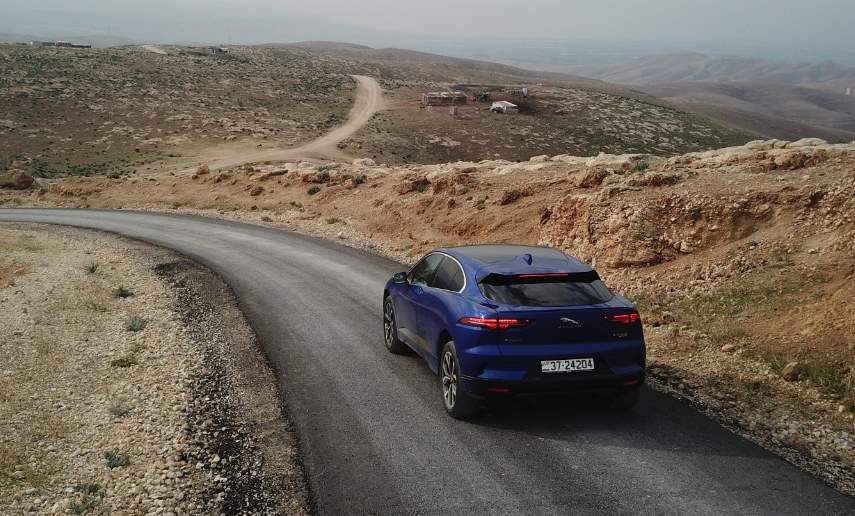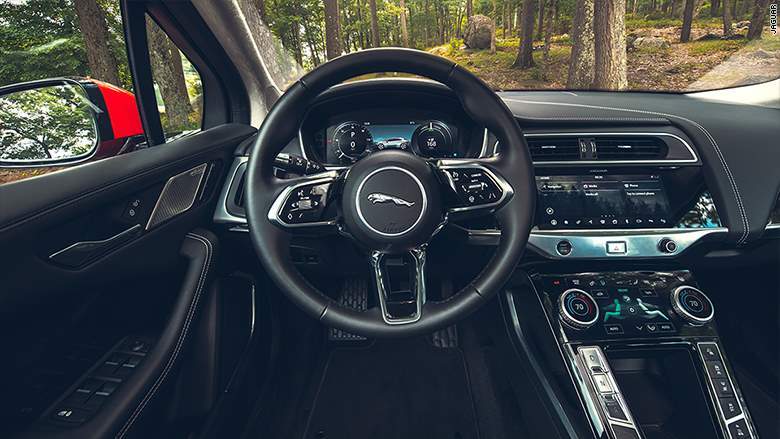For years, we have been hearing from
automakers that the future is in electric, luxury cars with advanced
communication technologies.
The
Jaguar I-Pace Experience offers a look into
that future, with its distinct look and high-tech features.
اضافة اعلان
Do not underestimate the power of
this car. The Jaguar I-Pace development enters a new era in the automotive world.
This is the first SUV designed exclusively as an electric car — by a
legacy car maker, that is.
The look is undoubtedly futuristic, Its details are elaborate, and its lines are distinctive. Just by looking at it
you can tell it is a Jaguar, with its traditional air intake and lights derived
from the hallmark F-TYPE model.
 (Photos: Handouts from Jaguar)
(Photos: Handouts from Jaguar)
Take a closer look, and you will discover
new details as well.
The Jaguar I-Pace has a length of 4.68m, a millimeter
difference from the Porsche Macan, Its wheelbase is 2.99m, which is about 20cm longer
than the Porsche’s and only one centimeter shorter than the Mercedes S-Class’s.
The reason for this is that the car is built on a flat base, where its battery
pack sits under the cabin.
On each end is an electric motor,
one driving the front axle and the other driving the rear axle, Without the
presence of traditional mechanical equipment (such as the gearbox, transmission
axles, exhaust pipes, etc.), both engines can be pushed as far as possible.
This is evident in the overhang space in front of the front axle, which is very
short, as its presence is required by car
safety laws.
The vehicle’s flat floor offers
riders more comfort, There is no need for a center bridge between the seats
— the center console provides deep storage spaces, and the floor in the
back is completely flat.
With its batteries positioned at
such a low level, the car has a low center of gravity, which reflects
positively on its performance and dynamic capabilities.
This also allows Jaguar
to adopt an advanced suspension system, with double triangles at the front and
integrated multi-link suspension at the rear for greater comfort and better
handling.
The absence of a large engine at the
front gives the car advantages as well. The traditional air vent is
unnecessary, but Jaguar designer Ian Callum kept it in place to preserve the
car’s identity and improve the vehicle's aerodynamic stability and aerodynamic
stability.
 (Photos: Handouts from Jaguar)
(Photos: Handouts from Jaguar)
On the inside, the car might not give
off a futuristic feel, but the interior equipment is unmistakably Jaguar-esque.
At first glance, you are met with three screens; one that replaces the
traditional gauges, and two on the dashboard that control the infotainment
system known as the company's Touch Pro Duo.
The seats, panoramic sunroof, and
large windows offer riders a sense of comfort and tranquility.
In terms of equipment, the Jaguar I-Pace
includes a powerful Meridian sound system, heated and cooled seats, USB
connections for various devices and charging points, Wi-Fi internet
connectivity, and other luxury amenities.
You won't realize the Jaguar I-Pace
has come to life until you look at the screen in front of you, There is no
gearshift knob, only three buttons bearing the letters N, D and R, Press D and
depress the accelerator pedal, and the car will start silently.
We all know that electric motors are
characterized by their large torque, but nothing will prepare you for what
happens when you hit the gas pedal hard for the first time.
This pedal does the
job perfectly. The Jaguar I-Pace features two electric motors, each producing
200 horsepower for a combined output of 400 horsepower.
But it is the 696 Nm
torque that dominates the driving experience.
The acceleration will surprise you,
as the Jaguar I-Pace could reach 100 km/h in 4.8 seconds, But mid-speed
acceleration is what distinguishes the I-PACE, shifting easily from 60 km/h to
100 or 160 km/h — something you wouldn’t expect from an EV.
After that initial shock wears off,
you quickly get used to driving and, inevitably, begin to compare the Jaguar I-Pace
with conventional gasoline cars.
First, the sound.
Jaguar has decided to create
a special pattern for the audio control inside the cabin. In standard mode, you
will not hear the engine, but if you switch to the dynamic mode, you will hear a
unique sound, like the "supercharger".
Second, the brakes.
The driver can
choose an "energy recovery" percentage for the brakes (i.e. the
process of converting kinetic energy into electrical energy that recharges the
car's batteries again).
You choose the normal mode, which won't feel any
different from any other car.
If you choose the more efficient charging mode,
you will, yet again, be surprised when you take your foot off the pedal.
The
feeling is similar to applying average pressure on brakes, where the driver can
drive the car using only the accelerator pedal.
Gear shifting will be missed.
The Jaguar
I-Pace, like other electric cars, does not transmit power through a gearbox, so
there is only the accelerator pedal to control the car.
 (Photos: Handouts from Jaguar)
(Photos: Handouts from Jaguar)
On gravel roads, the Jaguar I-Pace
is not an SUV in the traditional sense, but it is equipped with suspension and
driving modes, which allow it to run on unpaved roads.
The torque pays off here
with its instant response, limited wheel slip, and ease of driving in tough conditions.
It is this versatility that makes
the Jaguar I-Pace a new phenomenon in the automotive world.
But as in the case
of most electric cars, is the constant question: How much distance can be driven
by relying on batteries, and how much time does it require for charging?
Relying on a home charger, charging
a completely empty battery takes under 13 hours, while 10 hours are enough to
charge the battery to 80 percent.
Using the rapid charger with a power of 100
kilowatts fills up the battery in less than an hour, giving the car a range of
480km.
Because this car is the future,
handling the car's cargo is not that simple and Jaguar hasn't left it to
chance.
The car's navigation system has artificial intelligence. It learns your
driving style, and the system can read the terrain, know your permanent
destinations, and give you the actual expected range.
After testing the Jaguar I-Pace, I
can say with confidence that driving pleasure will not disappear, and that as
long as there are car companies that think like Jaguar and firmly believe that
the driver will always look for fun behind the wheel, the type of engine will
not matter.
FUN FACT
The Jaguar I-PACE
is the first electric SUV from a heritage British car maker.
Good
Distinctive
Jaguar design, luxurious interior, powerful electric powertrain
BAD
High price
AUTHOR’S RATING
9/10
BODY TYPE
SUV C EV
ENGINE
Lithium-ion
battery, 2 electric permanent magnet AC synchronous motors
TRANSMISMISSION
Single speed
automatic all-wheel drive,
electronic selection
ENGINE POWER
Horsepower: 400hp
/ Torque: 696NM
TOP SPEED
Km/h: 200
0 to 100km/h : 4.6
Electric Range
WLTP
Range 470km
DIMENSIONS
Length 4682mm - Width 2011mm - Height 1566mm - Wheelbase 2990mm - Curb weight 2208kg
PRICE
JD70,000
Read More Car news on
Drive




